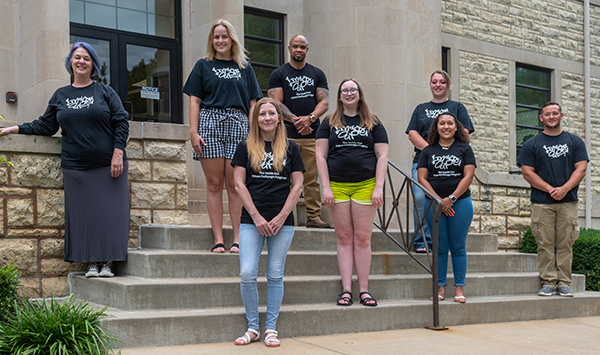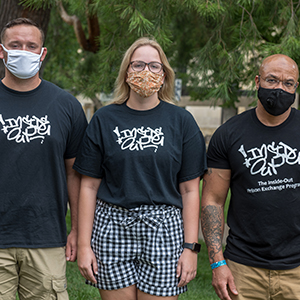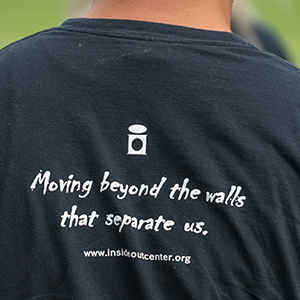Outside and Inside
Traditional students and prison inmates learn, share together in new program

From The Ichabod - Fall 2020
Orange jumpsuits, clanging bars, days spent in shackles and handcuffs – for people who have never been to prison, misconceptions about life as an inmate abound. But one aspect of prison life few people consider is the basic act of seeing a doctor to get routine health care. For Keely Jermark, ba '20, hearing female prisoners’ stories about seeing a physician were jarring.
“I felt morally challenged and profoundly saddened as my classmates revealed… being led to the back door of a doctor’s office in shackles instead of being checked in at the front desk, so as not to disturb law-abiding citizens waiting in the lobby,” said Jermark, who graduated this spring. “This has challenged me to advocate against stigma that incarcerated individuals receive during their sentence and even after they are released back into society.”
Jermark’s classmates were indeed inmates – this spring, 12 traditional Washburn students participated in the Inside-Out Prison Exchange Program, allowing them to gain new perspectives on the criminal justice system during a blended class with 12 incarcerated students at Topeka Correctional Facility. The quickest lesson learned was also the most vital: The students inside and outside the prison found out they actually had a lot in common.
“The most meaningful thing I learned was (discovering) my own biases and challenging them,” said outside student D’Mya Valdivia, certificate ’16, aa ’18. “What I thought about people in prison and how prisons are was not the reality. I learned that a lot of them were mothers and I learned how they were navigating that. It showed me that we are all human and go through a lot of the same experiences.”
“A lot of people see the criminal justice system as black and white. It’s really not that easy,” said inside student Catie Collins. “There’s a lot of gray area behind almost each and every inmate’s story, so to share that gray area was also amazing.”
Founded in Philadelphia in 1997, Inside-Out brings traditional students and incarcerated students together for criminal justice classes held in jails and prisons. The program has reached more than 50,000 students at more than 150 colleges and universities worldwide, with Washburn joining their ranks this spring and becoming the only school in Kansas to currently offer the course.
For Washburn University School of Law Professor Emily Grant, who received national training to lead the Inside-Out class, bringing it to Washburn’s Honors Program and the sociology and anthropology department allowed her to start important conversations about discrimination, race, gender and income inequality in the criminal justice system.
“One of the things I love about the class is I’m exposing college students to these thoughts at a time when they’re trying to decide what they want to devote their lives to and what they want to care about and reform – and if that ends up being the criminal justice system, all the better,” Grant said.
To help break down the natural divide between inside and outside students, icebreakers were essential, such as sharing their favorite breakfast cereals or cartoons growing up. This paved the way for weightier discussions by building a sense of trust and community among the students.
“At the start, both groups of people were worried about the same thing: Are they going to judge me? Are they going to accept me? Are they going to place any value on what I say?” Grant said. “But we’re more alike than we think. By week five, I was walking around looking at groups of students, and I got to one group and couldn’t remember who was inside and who was outside.”
In keeping with the program’s mission of treating students equally, both inside and outside students get three hours of college credit for the course. This spring, fundraising efforts spearheaded by Kerry Wynn, professor, history, and Honors Program director, raised enough to defray costs of tuition for the incarcerated women.
“Fundraising is crucial,” Wynn said. “This is a model that relies on inside and outside students coming in on equal footing and participating in the same class, so we wanted them all to get credit. We also wanted the inside students to be able to apply that credit later on if they get another degree.”
Though the immediate future of the program is uncertain due to COVID-19 restrictions, both Wynn and Grant are committed to keeping Inside-Out at Washburn. Based on the spring semester’s success, sustaining and expanding this educational model would be invaluable for both traditional and incarcerated students.
“This class was much more than I expected it to be and was so much fun,” Valdivia said. “After a while, you start to forget you're in a prison with inside students, and it just becomes a class. One of the hard parts was leaving at the end of class and realizing the inside students aren't leaving with you.”

